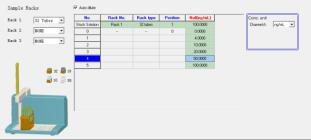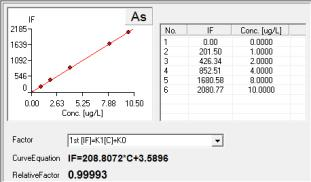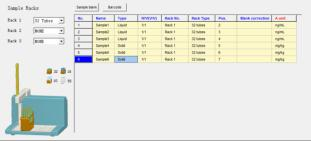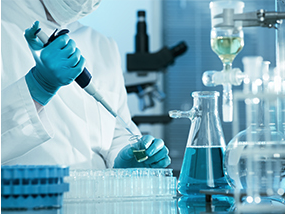Principle
The food samples are digested (by wet method) and then thiourea is added to reduce the total arsenic to As (III). Afterwards, the As (III) is reduced again to form Arsenic (III) Hydride, before it’s taken into the atomizer and becomes atomic arsenic. Then, it gives off atomic fluorescence when being illuminated by hollow cathode lamp. The intensity of fluorescence is proportionate to arsenic concentration under designated situations and it’s calculated by the standard solutions.
Reagents and Equipment
Instrument:
1. PERSEE PF7 Heavy metal analyzer, with Arsenic hollow cathode lamp;
2. Analytical balance;
3. High speed homogenizer
4. Hotplate
Reagent:
1. Sodium hydroxide (NaOH)
2. Potassium hydroxide (KOH)
3. Potassium borohydride (KBH4)
4. Thiourea (CH4 N2 02S)
5. Hydrochloric acid (HCl)
6. Nitrous acid (HN03)
7. Sulfuric acid (H2S04)
8. Perchloric acid (HCl04)
9. Magnesium nitrate [Mg(N03) 2 ·6H2 0]
10. Magnesium oxide (MgO)
11. Ascorbic acid (C6 H8 06)
Chemical solutions preparation:
1. Potassium hydroxide solution (5 g/L): weigh 5.0 g potassium hydroxide, dissolve and dilute to 1000 mL.
2. Potassium borohydride solution (20 g/L): weigh potassium borohydride 20.0 g,dissolve in 1000 mL 5g/L potassium hydroxide solution and mix well.
3. Thiourea + ascorbic acid solution: weigh 10.0 g thiourea, add about 80 mL water, warm up to dissolve. Let solution cool to ambient temperature, then add 10.0 g ascorbic acid and dilute to 100 mL. Prepare this solution freshly.
4. Sodium hydroxide solution (100 g/L): dissolve 10.0 g sodium hydroxide into water and dilute to 100 mL.
5. Nitrous magnesium solution (150 g/L): weigh 15.0 g nitrous magnesium, dissolve in water and dilute to 100 mL.
6. Hydro chloric acid (1+1): take 100 mL hydrochloric acid, add it into 100 mL water slowly. Mix well.
7. Sulfuric acid (1+9): take 100 mL sulfuric acid, add it into 900 mL water slowly. Mix well.
8. Nitrous acid (2+98): take 20 mL nitrous acid, add it into 980 mL water and mix well.
Standard substance:
Arsenic trioxide standard substance, purity ≥ 99.5%
Sample preparation
1. Arsenic standard stock solution (100 mg/L, calculated as As):
Accurately weigh 0.0132 g Arsenic trioxide (after being oven dried in oven at 100C for 2 hrs.), add 1 mL sodium hydroxide solution (100 g/L) and some water to dissolve. Then, transfer the mixture to a 100 mL volumetric flask and add hydrochloric acid to adjust pH to neutral. Dilute volume to 100 mL mark.
2. Arsenic standard solution (1.00 mg/L, as As):
pipette 1.00 mL [Arsenic standard stock solution (100 mg/L, calculated as As)] into 100 mL volumetric flask. Dilute to mark by nitrous acid (2+98). Use freshly prepared solutions.
Sample Preparation
1. Ensure that all samples aren’t contaminated. Prepare samples like below:
a) For cereals and beans samples, grind sample up evenly and store samples in polyethylene bottles.
b) For vegetables, fruits, fish, meat and eggs, take homogenized edible part and store samples in polyethylene bottles at 4C.
2. Wet digestion method:
a) For solid samples, take 1.0-2.5 g, for liquid samples, take 5.0- 10.0 g (or mL) into 50- 100 mL conical flask. Make 2 blank solutions as well.
b) Add 20 mL nitrous acid, 4 mL perchloric acid, 1.25 mL sulfuric acid and let sit overnight.
c) Put conical flasks on hotplate, heat up and start digestion.
d) If remaining solution is less than 1 mL and there’s still dark substance present, let solution cool and add more nitrous acid 5- 10 mL, warm up and digest until less than 2 mL solution left. Repeat the process if dark substance still present, until the solution is clear.
e) Continuously heat sample on the hotplate until white smoke appears. Then, let cool and add 25 mL water. Heat solution up again until white smoke appears again.
3. Let cool and transfer remaining liquid to 25 mL volumetric flask. Add 2 mL [Thiourea + ascorbic acid solution] and dilute solution with water to 25 mL mark. Let solution sit for 30 mins before testing. Do the same to reagent blank.
Instrumental parameters

Calibration curve making
1. Take 2.5 mL [Arsenic standard solution
(1.00 mg/L, as Arsenic)] into 25 mL volumetric flask, add 12.5 mL sulfuric acid (1+9) & 2 mL [Thiourea + ascorbic acid solution]. Dilute solution to 25 mL mark and mix well. Set for 30mins before testing. This standard contains Arsenic of 100 ng/mL.
2. Use this solution on the PF7 and use
auto-dilution function to dilute the standard to 4.0 ng/mL, 10 ng/mL, 20 ng/mL, 50 ng/mL. See in the figure below.

Create standard curve using those concentrations. In PERSEE AFWIN software, after it’s done with all the standard concentrations, a calibration curve would be generated automatically. See in the example below:

Testing ofthe sample solutions
Put the sample solutions from [sample preparation-step 3] in the sample rack and set the testing procedures on AFWIN software. See in the figure below.

Analysis ofthe results
Calculate the total Arsenic concentration as in the formula below:
![]()
In which:
X – Arsenic concentration in original sample, in mg/kg or mg/L
c – Arsenic concentration in the testing solution (ng/mL)
c0 – Arsenic concentration in blank sample (ng/mL)
V – total volume of digestion solution, (mL), should be 25 mL in this method
m – mass of original sample, in grams or mL 1000 – calculation rate






